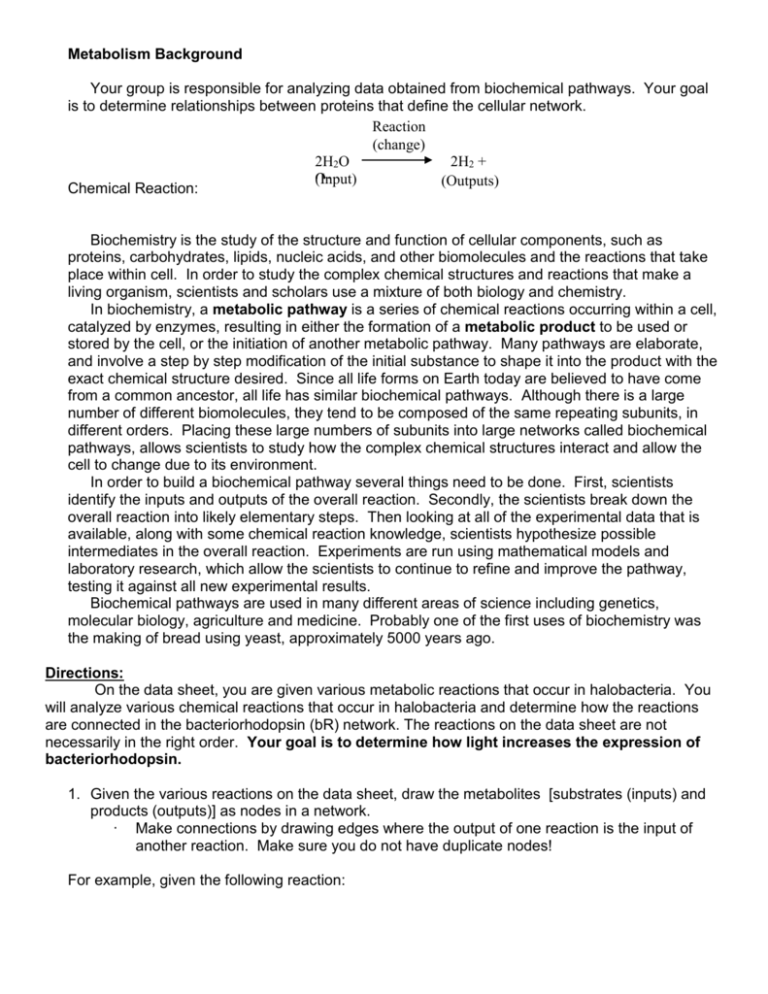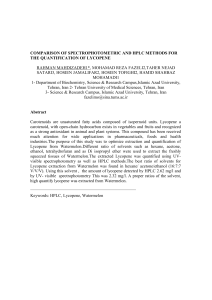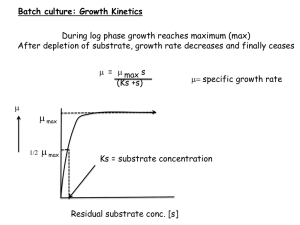Condensed version-includes all documents above
advertisement

Metabolism Background Your group is responsible for analyzing data obtained from biochemical pathways. Your goal is to determine relationships between proteins that define the cellular network. Reaction (change) 2H2O 2H2 + O2 (Input) (Outputs) Chemical Reaction: Biochemistry is the study of the structure and function of cellular components, such as proteins, carbohydrates, lipids, nucleic acids, and other biomolecules and the reactions that take place within cell. In order to study the complex chemical structures and reactions that make a living organism, scientists and scholars use a mixture of both biology and chemistry. In biochemistry, a metabolic pathway is a series of chemical reactions occurring within a cell, catalyzed by enzymes, resulting in either the formation of a metabolic product to be used or stored by the cell, or the initiation of another metabolic pathway. Many pathways are elaborate, and involve a step by step modification of the initial substance to shape it into the product with the exact chemical structure desired. Since all life forms on Earth today are believed to have come from a common ancestor, all life has similar biochemical pathways. Although there is a large number of different biomolecules, they tend to be composed of the same repeating subunits, in different orders. Placing these large numbers of subunits into large networks called biochemical pathways, allows scientists to study how the complex chemical structures interact and allow the cell to change due to its environment. In order to build a biochemical pathway several things need to be done. First, scientists identify the inputs and outputs of the overall reaction. Secondly, the scientists break down the overall reaction into likely elementary steps. Then looking at all of the experimental data that is available, along with some chemical reaction knowledge, scientists hypothesize possible intermediates in the overall reaction. Experiments are run using mathematical models and laboratory research, which allow the scientists to continue to refine and improve the pathway, testing it against all new experimental results. Biochemical pathways are used in many different areas of science including genetics, molecular biology, agriculture and medicine. Probably one of the first uses of biochemistry was the making of bread using yeast, approximately 5000 years ago. Directions: On the data sheet, you are given various metabolic reactions that occur in halobacteria. You will analyze various chemical reactions that occur in halobacteria and determine how the reactions are connected in the bacteriorhodopsin (bR) network. The reactions on the data sheet are not necessarily in the right order. Your goal is to determine how light increases the expression of bacteriorhodopsin. 1. Given the various reactions on the data sheet, draw the metabolites [substrates (inputs) and products (outputs)] as nodes in a network. · Make connections by drawing edges where the output of one reaction is the input of another reaction. Make sure you do not have duplicate nodes! For example, given the following reaction: arginine L-arginosuccinate …you would draw the following L-arginosuccinate arginine *Notice that even though there is another product in the reaction, only the product that is labeled in the data sheet, arginine, is drawn in the network. Draw Network Here: METABOLISM DATA SHEET Substrate: beta-caroteneProduct: Retinal Substrate: LycopeneProduct: Beta-carotene Substrate: Retinal and BOP proteinProduct: Bacteriorhodopsin Substrate: GG-PP Product: Phytoene Substrate: Phytoene Product: Lycopene Analysis Questions 1. In a metabolic network, what do the nodes represent? What do the edges represent? 2. What would happen to the network if there were more GG-PP? How would this affect the amount of bacteriorhodopsin produced? Explain your reasoning. 3. If the amount of lycopene decreases what will happen to the metabolites below? (Circle your choice) · GG-PP Explain: increase decrease stay the same · Phytoene Explain: increase decrease stay the same · Bacteriorhodopsin increase Explain: decrease stay the same 4. How is the amount of product controlled in this network? Give three possible ways. • • • 5. What would make it necessary for a cell to control the amount of product? KEY FOR METABOLISM DATA Example of Student Network for Metabolism Data Beta Carotene Retinal Lycopen e bop Bacteriorhodo psin Phytoene GG-PP Note: Bop combines with retinal to form bacteriorhodopsin Analysis Questions 1. In a metabolic network, what do the nodes represent? What do the edges represent? In a metabolic network the nodes are metabolites and the edges are enzymes. 2. What would happen to the network if there were more GG-PP? How would this affect the amount of bacteriorhodopsin produced? Explain your reasoning. In the network if there was more GG-PP, then there would be more of all of the other metabolites including bacteriorhodopsin. With more GG-PP to begin with, more phytoene can be formed. With more phytoene, more lycopene can be formed. With more lycopene, more beta carotene can be formed. With more beta carotene, more retinal can be formed. If there is more retinal to combine with the bop protein, then more bacteriorhodopsin will be produced. 3. If the amount of lycopene decreases what will happen to the metabolites below? (Circle your choice) · GG-PP Explain: increase decrease stay the same · Phytoene Explain: increase decrease stay the same · Bacteriorhodopsin increase decrease stay the same Explain: If the amount of lycopene in the network decreased, then the amounts of the metabolites beta carotene, retinal and bacteriorhodopsin would also decrease. With less lycopene, less beta carotene can be formed. With less beta carotene, less retinal can be formed. If there is less retinal to combine with the bop protein, then less bacteriorhodopsin will be produced. If the reaction converting beta carotene to retinal was not able to take place then no retinal or bacteriorhodopsin would be formed. There would be a build up of beta carotene because it wouldn’t be able to be converted to retinal. The other metabolites (GG-PP, phytoene, and lycopene) would be unaffected. 5. How is the amount of product controlled in this network? Give three possible ways. The amount of product is regulated by the amount of substrate (and the activity/amount of the enzyme that converts the product to the substrate. Possible explanations for what regulates the network include: controlling the amount of enzyme produced, controlling the amount of substrate in the cell, etc. All of the reactions are not occurring simultaneously. The cell regulates the metabolic pathway depending on the products needed. 6. What would make it necessary for a cell to control the amount of product? Answers may vary. Possible student responses include: (1) the amount of metabolites are controlled in the cell or (2) the enzymes that convert the substrate to product are regulated. In order to test (1) information on how the cell obtains the metabolites and information on how the cell regulates the metabolites. In order to test (2) information about the enzymes involved in the reactions would be needed. Information about how the over expression or under expression of these enzymes and their affect on the chemical reactions






